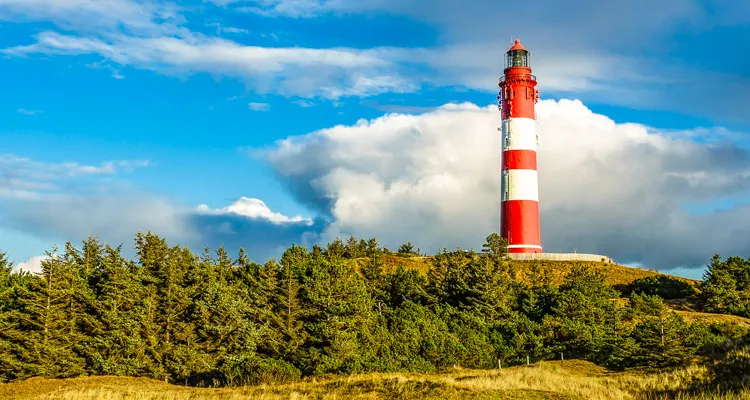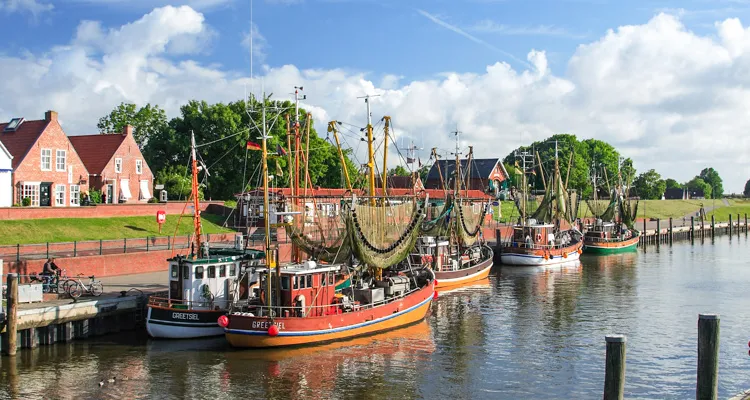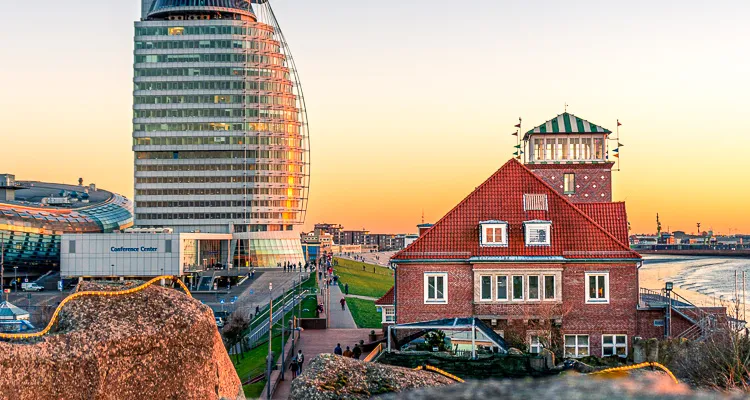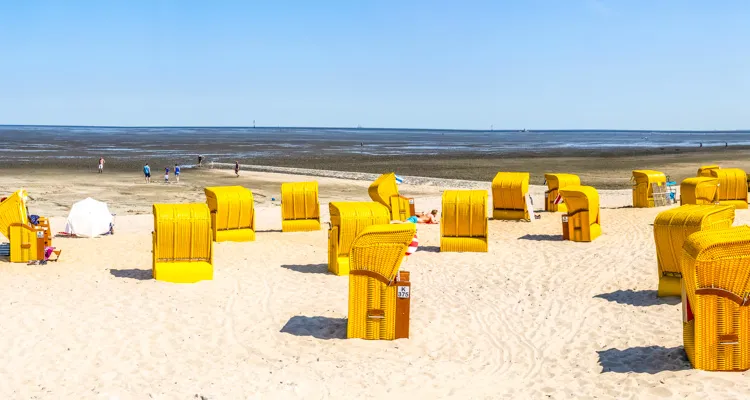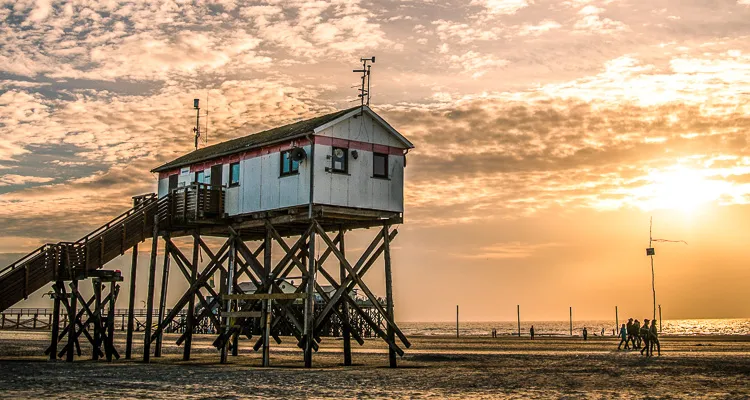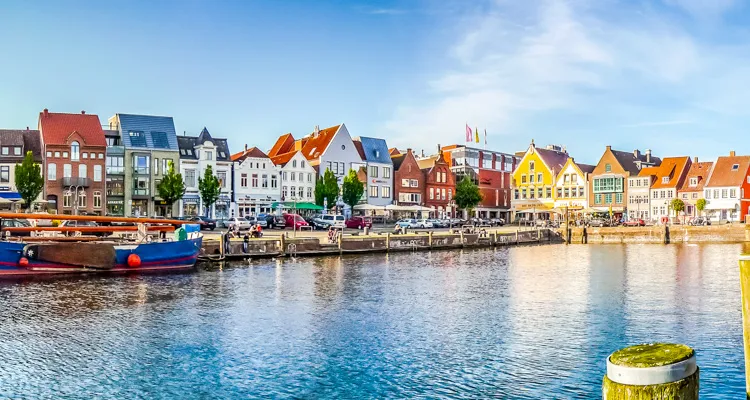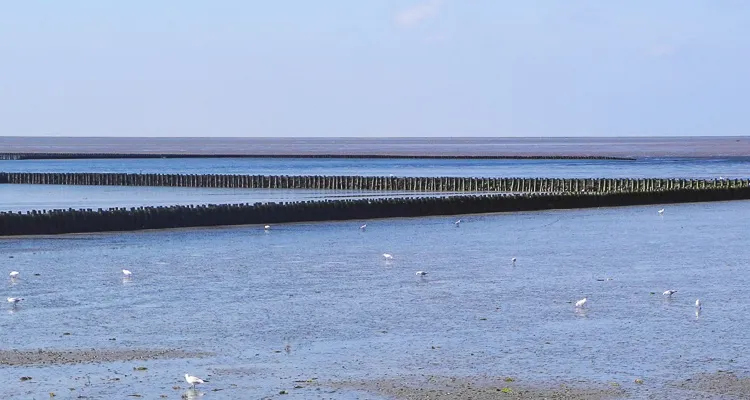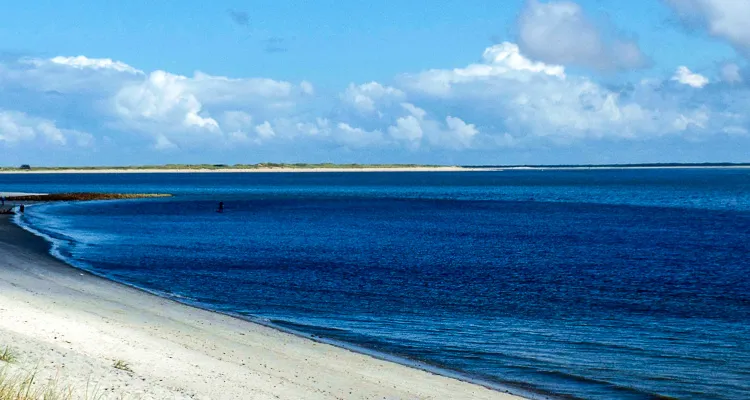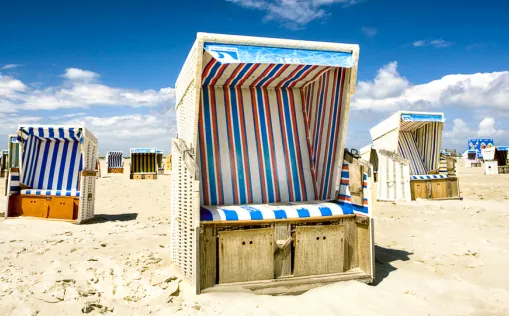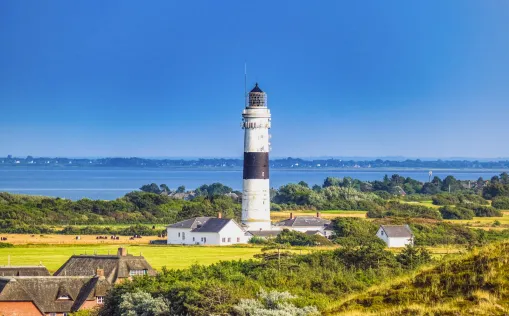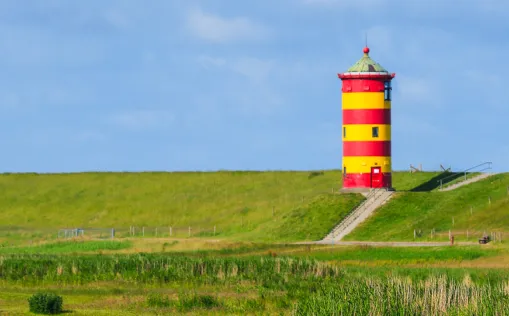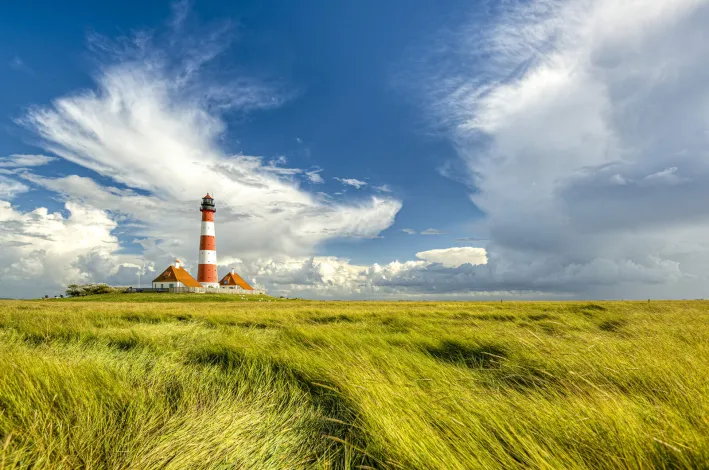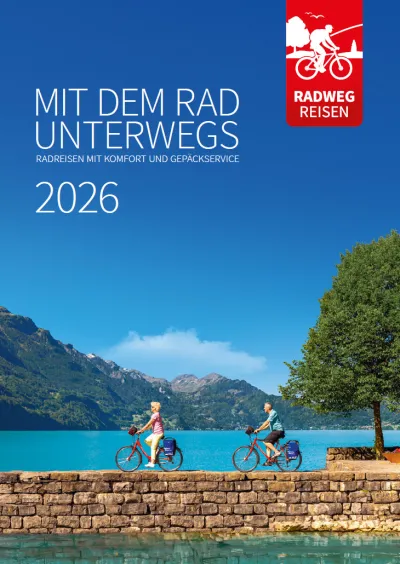

The North Sea Cycle Route
On the road near the coast from the Dutch border to the north of Schleswig-Holstein
The Wadden Sea, thatched houses, shrimp boats, endless expanses, and the glittering sea - on the North Sea Cycle Route you will experience the perfect North Sea holiday! The North Sea Cycle Route is a nearly 900-kilometre section of the approximately 6000-kilometre North Sea Coast Cycle Route. It leads through a total of six countries from the Shetland Islands in Scotland to Bergen in Norway. In Germany, it runs from the Dutch border along the Ems to Emden, follows the coast of East Frisia, and crosses the Weser at Bremerhaven. From Cuxhaven, it takes you through the Alte Land to Hamburg. Following the Elbe, you cross the Kiel Canal and pass the Dithmarschen and the coast of North Frisia to the border of Denmark.
Well-developed and signposted, the North Sea Cycle Route along the Wadden Sea, through marshland and geest areas, and in the historic and picturesque harbor towns offers almost gradient-free cycling pleasure. Fresh wind, healthy sea air, colorful lighthouses, and the interplay of the tides make cycling on the North Sea Cycle Route an exciting and varied North Sea experience. Be sure to bring your swimsuit! The kilometers of sandy beaches along the coast and on the East and North Frisian Islands are among the sunniest in Germany. Ideal for spontaneously plunging into the waters along the North Sea Cycle Route or simply switching off and enjoying yourself.
Speaking of enjoyment: there's nothing like a hearty fish sandwich at the North Sea! But a snirtjebraten, Frisian cake, and Pharisee are also among the traditional and varied delicacies on the coast. Not to forget the famous Teetied, which is celebrated by the East Frisians on many occasions.
On this page you can find out more about the course of the North Sea Cycle Route, its topography, signposting as well as tips on how to get there, the ideal time to travel, and shortcuts. Be inspired by our cycling holidays at the North Sea. We will be happy to advise you! From hotel bookings to luggage transport - cycle with us carefree along the North German coast!
Show more Show lessIn a nutshell: The North Sea Cycle Route
- Length
approx. 900 km - Topography
The elevation profile is mostly flat due to the landscape with only a few small inclines. - Signposting
The logo shows a dark blue bicycle on a light blue background with the words North Sea Cycle Route. In Germany, the North Sea Cycle Route is also known as D-Route 1. Half of the circular waymark is marked with a wheel and half with a red 1. - Quality
The cycle route mainly runs on cycle paths along the dykes, along roads, or on quiet country roads. Gravel and sand paths as well as cobblestone roads are to be expected in places. Be prepared for obstacles (sheep, sheep gates) or dirt (sheep droppings, flotsam) on the dykes. Please note that there are cattle gates on dykes that restrict the width of passage for child trailers and wide saddlebags.
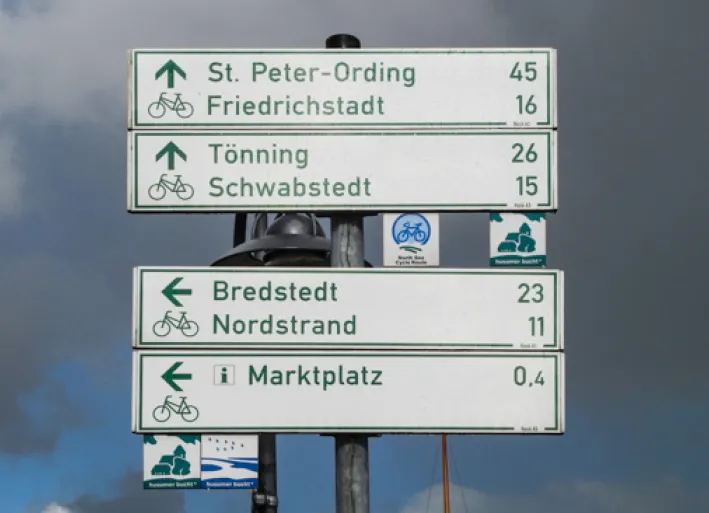
Worth knowing
The North Sea Cycle Route (also known as the North Sea Coast Cycle Route or EuroVelo Route 12) is around 6000 kilometers long in total, making it the longest signposted cycle route in the world. It begins on the Scottish Shetland Islands and mostly follows the Scottish and English North Sea coast. In Harwich, the cycle route crosses the North Sea by ferry and continues its course near Rotterdam. It follows the Dutch and German North Sea coasts. In Denmark, it follows the coast to Skagen, the country's northernmost town. Along the east coast of Jutland, it reaches Grenå. A ferry takes you across the Kattegat to Varberg in Sweden. Following the Swedish west coast and the southern Norwegian archipelago, the route ends in Bergen, Norway.
Show more Show lessOn the way from East Frisia via Hamburg to the North Sea coast of Schleswig-Holstein
The German section of the North Sea Cycle Route begins not far from the small town of Bunde, near the Dutch border. On a flat cycle path, you reach Leer, the gateway to East Frisia. Along the Ems, you get to know Emden, the largest East Frisian city. In Emden, you have the option of taking a ferry to the East Frisian island of Borkum. Along the Wadden Sea you will get to know the red and yellow Pilsum lighthouse, the twin mills in Greetsiel, and the seal station in Norden. Speaking of seals: with a bit of luck, you can observe seals and seals cavorting on the sandbanks during excursions to the islands of Norderney and Langeoog. Through Harlingerland you follow the North Sea coast to the fishing village of Carolinensiel. You leave the coast and experience the town of Jever, famous for its tart beer, and the naval city of Wilhelmshaven.
You cycle around the Jade Bight and the North Sea peninsula of Butjadingen and reach the Weser. Take the Weser ferry across to Bremerhaven. Visit the German Maritime Museum and the Loschenturm, one of the landmarks of the maritime city. Along the North Sea, your next destination is Cuxhaven. The town's landmark is the Kugelbake. The striking sea marker marks the transition from the Lower to the Outer Elbe. Away from the North Sea and the Elbe, you cycle to Stade. Passing countless apple trees and impressive farms, you reach the Alte Land, the largest contiguous fruit-growing area in Northern Europe. Your next destination is the Hanseatic city of Hamburg. The cosmopolitan metropolis on the Elbe impresses with a variety of cultural offerings and a wealth of sights. Get to know one of the largest ports in Europe and fortify yourself with a hearty Hamburg eel soup.
On we go! Now in Schleswig-Holstein, you will cycle through Elmshorn, the matjee town of Glückstadt, and Brunsbüttel, which is characterized by its location on the Kiel Canal. Say goodbye to the Elbe for a few kilometers and cycle through the Dithmarschen via St. Michaelisdonn and Meldorf back to the North Sea. Taste freshly caught crabs in Büsum, cross the Eider Barrage – Germany's largest coastal protection structure - and enjoy relaxing moments on the 12-kilometre-long sandy beach in St. Peter-Ording. Welcome to North Frisia! Via the Eiderstedt peninsula, you reach the colorful harbor town of Husum. You cycle around the Nordstrand peninsula and follow the cycle path along the North Sea to Dagebüll. From Dagebüll you can reach the North Frisian islands of Föhr and Amrum as well as the Hallig Hooge by ferry. A little away from the North Sea, you will get to know the climatic health resort of Niebüll. Combine your stay in Niebüll with a trip to the island of Sylt. The expressionist painter Emil Nolde once lived and worked in Seebüll, a few kilometers to the north, and the Emil Nolde Museum is dedicated to him. In the nearby village of Rosenkranz, you will reach the German-Danish border.
Show more Show lessTravel time
The best time to travel to the North Sea coast is during the summer months. Mild and moderately warm temperatures, and many hours of sunshine but also spontaneously changing weather characterize the time between June and September. Summertime is bathing time! However, you should expect the water temperatures to be a bit chilly at times. If you don't want to spend too much time on the beach and want to enjoy the quiet low season, spring is ideal for cycling along the North Sea coast. It usually gets uncomfortable from October onwards, as this is the time of year with the highest precipitation and many storms.
Keep in mind that you should always have wind- and rain-proof clothing handy when traveling on the North Sea Cycle Route, regardless of the season, as stiff breezes and changeable weather are to be expected all year round. Since the wind on the North Sea usually comes from the west and southwest, we recommend that you travel the North Sea Cycle Route from south to north.
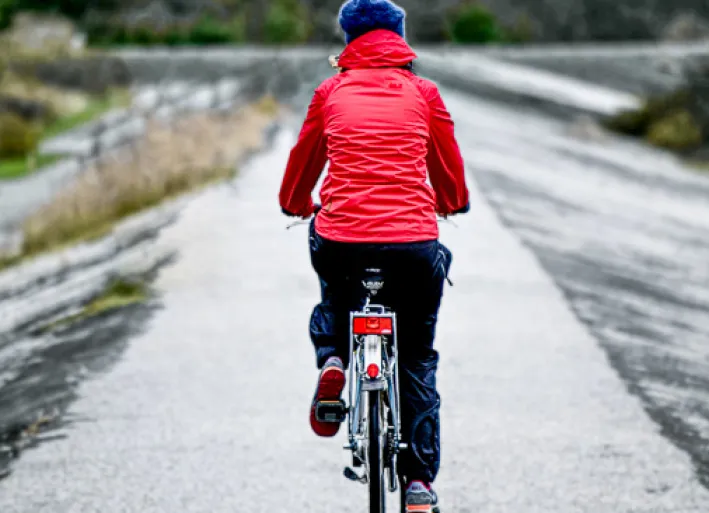
Arrival
If you want to cycle the North Sea Cycle Route with your own bike, we recommend that you travel by car or by train. Many larger towns along the coast of Lower Saxony and Schleswig-Holstein, as well as the city of Hamburg, are connected by regional and long-distance Deutsche Bahn services. Find out before you travel by train whether your chosen connection allows you to take your bike with you. The cities of Emden, Wilhelmshaven, Bremerhaven, Cuxhaven, and Hamburg are connected to the German motorway network, other places can be reached via federal roads. If you choose to travel by car, we recommend that you rent a parking space for the entire duration of the tour or park your car in a paid parking garage. If you have a long journey or have booked a rental bike, we recommend using Hamburg and Bremen airports in addition to the car and train. Some places along the cycle path can be reached by long-distance bus. Bicycle transport is limited and must be reserved.
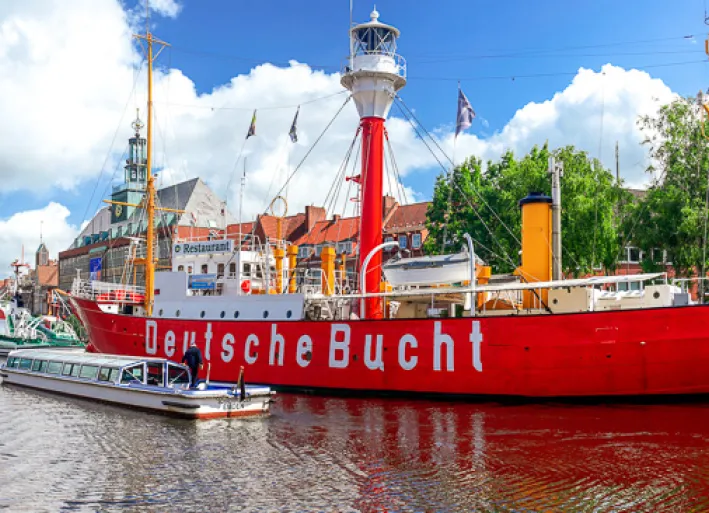
Shortcuts
In case of bad weather (the so-called Schietwetter) or an unforeseen breakdown, you can bridge or shorten your stage(s) by train. The railway lines in East and North Frisia do not run directly along the cycle path, so expect detours to get to a station. Please note that it is only possible to take bicycles on trains to a limited extent.
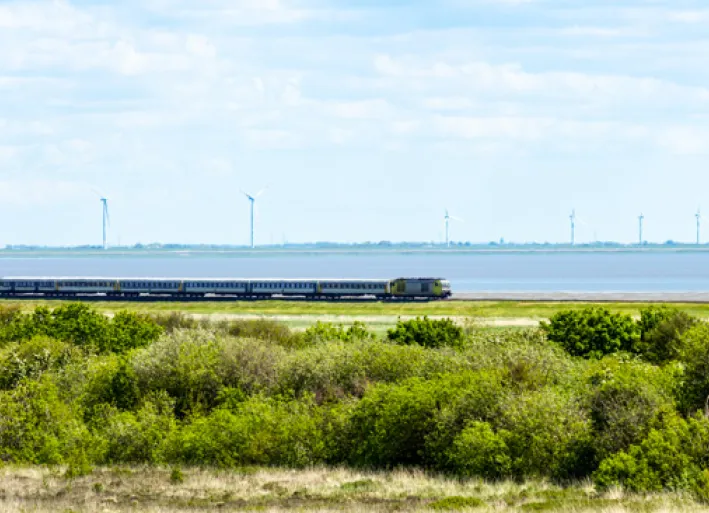
Who is out and about on the North Sea Cycle Path?
Thanks to the almost negligible gradients and good road conditions, the North Sea Cycle Route is ideal for recreational cyclists, beginner cyclists, and families with children. You can easily make detours inland, as there are also many attractive sights and places and varied landscapes away from the coast. The route is suitable for almost all bikes. Road cyclists can also use the route but must be prepared for rough sections, which can be avoided by taking alternative routes.
Show more Show less

